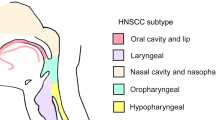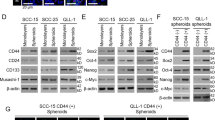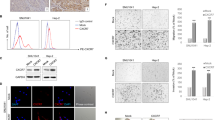Abstract
11q13 amplification is a late-stage event in several cancers that is often associated with poor prognosis. Among 11q13-amplified genes, the actin assembly protein cortactin/CTTN is considered a likely candidate for direct involvement in tumor progression because of its cell motility-enhancing functions. We modulated cortactin expression in head and neck squamous cell carcinoma (HNSCC) cell lines. Cortactin expression levels directly correlated with tumor size, vascularization and cell proliferation in an orthotopic HNSCC in vivo model. In contrast, under normal in vitro culture conditions, cortactin expression levels had no effect on cell proliferation. However, cell lines in which cortactin expression was reduced by knockdown (KD) grew poorly in vitro under harsh conditions of growth factor deprivation, anchorage independence and space constraint. In contrast, overexpression of cortactin enhanced in vitro growth under the same harsh conditions. Surprisingly, defects in growth factor-independent proliferation of cortactin-KD cells were rescued by coculture with cortactin-expressing cells. As the cocultured cells are separated by permeable filters, cortactin-expressing cells must secrete growth-supporting autocrine factors to rescue the cortactin-KD cells. Overall, cortactin expression modulates multiple cellular traits that may allow survival in a tumor environment, suggesting that the frequent overexpression of cortactin in tumors is not an epiphenomenon but rather promotes tumor aggressiveness.
This is a preview of subscription content, access via your institution
Access options
Subscribe to this journal
Receive 50 print issues and online access
$259.00 per year
only $5.18 per issue
Buy this article
- Purchase on Springer Link
- Instant access to full article PDF
Prices may be subject to local taxes which are calculated during checkout







Similar content being viewed by others
References
Akervall JA, Jin Y, Wennerberg JP, Zatterstrom UK, Kjellen E, Mertens F et al. (1995). Chromosomal abnormalities involving 11q13 are associated with poor prognosis in patients with squamous cell carcinoma of the head and neck. Cancer 76: 853–859.
Bates SE, Valverius EM, Ennis BW, Bronzert DA, Sheridan JP, Stampfer MR et al. (1990). Expression of the transforming growth factor-alpha/epidermal growth factor receptor pathway in normal human breast epithelial cells. Endocrinology 126: 596–607.
Bryce NS, Clark ES, Leysath JL, Currie JD, Webb DJ, Weaver AM . (2005). Cortactin promotes cell motility by enhancing lamellipodial persistence. Curr Biol 15: 1276–1285.
Cao H, Orth JD, Chen J, Weller SG, Heuser JE, McNiven MA . (2003). Cortactin is a component of clathrin-coated pits and participates in receptor-mediated endocytosis. Mol Cell Biol 23: 2162–2170.
Cao H, Weller S, Orth JD, Chen J, Huang B, Chen JL et al. (2005). Actin and Arf1-dependent recruitment of a cortactin–dynamin complex to the Golgi regulates post-Golgi transport. Nat Cell Biol 7: 483–492.
Chuma M, Sakamoto M, Yasuda J, Fujii G, Nakanishi K, Tsuchiya A et al. (2004). Overexpression of cortactin is involved in motility and metastasis of hepatocellular carcinoma. J Hepatol 41: 629–636.
Clark ES, Weaver AM . (2008). A new role for cortactin in invadopodia: regulation of protease secretion. Eur J Cell Biol 87: 581–590.
Clark ES, Whigham AS, Yarbrough WG, Weaver AM . (2007). Cortactin is an essential regulator of matrix metalloproteinase secretion and extracellular matrix degradation in invadopodia. Cancer Res 67: 4227–4235.
Debnath J, Brugge JS . (2005). Modelling glandular epithelial cancers in three-dimensional cultures. Nat Rev Cancer 5: 675–688.
Debnath J, Muthuswamy SK, Brugge JS . (2003). Morphogenesis and oncogenesis of MCF-10A mammary epithelial acini grown in three-dimensional basement membrane cultures. Methods 30: 256–268.
Ethier SP, Langton BC, Dilts CA . (1996). Growth factor-independent proliferation of rat mammary carcinoma cells by autocrine secretion of neu-differentiation factor/heregulin and transforming growth factor-alpha. Mol Carcinog 15: 134–143.
Ethier SP, Moorthy R, Dilts CA . (1991). Secretion of an epidermal growth factor-like growth factor by epidermal growth factor-independent rat mammary carcinoma cells. Cell Growth Differ 2: 593–602.
Freier K, Sticht C, Hofele C, Flechtenmacher C, Stange D, Puccio L et al. (2006). Recurrent coamplification of cytoskeleton-associated genes EMS1 and SHANK2 with CCND1 in oral squamous cell carcinoma. Genes Chromosomes Cancer 45: 118–125.
Gabrilove JL . (2001). Angiogenic growth factors: autocrine and paracrine regulation of survival in hematologic malignancies. Oncologist 6 (Suppl 5): 4–7.
Gibcus JH, Mastik MF, Menkema L, de Bock GH, Kluin PM, Schuuring E et al. (2008). Cortactin expression predicts poor survival in laryngeal carcinoma. Br J Cancer 98: 950–955.
Gibcus JH, Menkema L, Mastik MF, Hermsen MA, de Bock GH, van Velthuysen ML et al. (2007). Amplicon mapping and expression profiling identify the Fas-associated death domain gene as a new driver in the 11q13.3 amplicon in laryngeal/pharyngeal cancer. Clin Cancer Res 13: 6257–6266.
Greer Jr RO, Said S, Shroyer KR, Marileila VG, Weed SA . (2007). Overexpression of cyclin D1 and cortactin is primarily independent of gene amplification in salivary gland adenoid cystic carcinoma. Oral Oncol 43: 735–741.
Hanahan D, Weinberg RA . (2000). The hallmarks of cancer. Cell 100: 57–70.
Hiratsuka S, Watanabe A, Aburatani H, Maru Y . (2006). Tumour-mediated upregulation of chemoattractants and recruitment of myeloid cells predetermines lung metastasis. Nat Cell Biol 8: 1369–1375.
Hofman P, Butori C, Havet K, Hofman V, Selva E, Guevara N et al. (2008). Prognostic significance of cortactin levels in head and neck squamous cell carcinoma: comparison with epidermal growth factor receptor status. Br J Cancer 98: 956–964.
Hui R, Ball JR, Macmillan RD, Kenny FS, Prall OW, Campbell DH et al. (1998). EMS1 gene expression in primary breast cancer: relationship to cyclin D1 and oestrogen receptor expression and patient survival. Oncogene 17: 1053–1059.
Karnoub AE, Dash AB, Vo AP, Sullivan A, Brooks MW, Bell GW et al. (2007). Mesenchymal stem cells within tumour stroma promote breast cancer metastasis. Nature 449: 557–563.
Katsube T, Togashi S, Hashimoto N, Ogiu T, Tsuji H . (2004). Filamentous actin binding ability of cortactin isoforms is responsible for their cell-cell junctional localization in epithelial cells. Arch Biochem Biophys 427: 79–90.
Li Y, Tondravi M, Liu J, Smith E, Haudenschild CC, Kaczmarek M et al. (2001). Cortactin potentiates bone metastasis of breast cancer cells. Cancer Res 61: 6906–6911.
Luo ML, Shen XM, Zhang Y, Wei F, Xu X, Cai Y et al. (2006). Amplification and overexpression of CTTN (EMS1) contribute to the metastasis of esophageal squamous cell carcinoma by promoting cell migration and anoikis resistance. Cancer Res 66: 11690–11699.
Markowitz SD, Molkentin K, Gerbic C, Jackson J, Stellato T, Willson JK . (1990). Growth stimulation by coexpression of transforming growth factor-alpha and epidermal growth factor-receptor in normal and adenomatous human colon epithelium. J Clin Invest 86: 356–362.
Meredith SD, Levine PA, Burns JA, Gaffey MJ, Boyd JC, Weiss LM et al. (1995). Chromosome 11q13 amplification in head and neck squamous cell carcinoma. Association with poor prognosis. Arch Otolaryngol Head Neck Surg 121: 790–794.
Merrifield CJ, Perrais D, Zenisek D . (2005). Coupling between clathrin-coated-pit invagination, cortactin recruitment, and membrane scission observed in live cells. Cell 121: 593–606.
Myllykangas S, Bohling T, Knuutila S . (2007). Specificity, selection and significance of gene amplifications in cancer. Semin Cancer Biol 17: 42–55.
Ohoka Y, Takai Y . (1998). Isolation and characterization of cortactin isoforms and a novel cortactin-binding protein, CBP90. Genes Cells 3: 603–612.
Ormandy CJ, Musgrove EA, Hui R, Daly RJ, Sutherland RL . (2003). Cyclin D1, EMS1 and 11q13 amplification in breast cancer. Breast Cancer Res Treat 78: 323–335.
Ostman A . (2004). PDGF receptors-mediators of autocrine tumor growth and regulators of tumor vasculature and stroma. Cytokine Growth Factor Rev 15: 275–286.
Rangan SR . (1972). A new human cell line (FaDu) from a hypopharyngeal carcinoma. Cancer 29: 117–121.
Rodrigo JP, Garcia LA, Ramos S, Lazo PS, Suarez C . (2000). EMS1 gene amplification correlates with poor prognosis in squamous cell carcinomas of the head and neck. Clin Cancer Res 6: 3177–3182.
Schuuring E, Verhoeven E, Mooi WJ, Michalides RJ . (1992). Identification and cloning of two overexpressed genes, U21B31/PRAD1 and EMS1, within the amplified chromosome 11q13 region in human carcinomas. Oncogene 7: 355–361.
Schuuring E . (1995). The involvement of the chromosome 11q13 region in human malignancies: cyclin D1 and EMS1 are two new candidate oncogenes—a review. Gene 159: 83–96.
Shores CG, Yarbrough WG . (1998). Three-dimensional xenograft model of dysplastic human laryngeal mucosa. Laryngoscope 108: 1358–1362.
Somers KD, Cartwright SL, Schechter GL . (1990). Amplification of the int-2 gene in human head and neck squamous cell carcinomas. Oncogene 5: 915–920.
Takes RP, Baatenburg de Jong RJ, Schuuring E, Hermans J, Vis AA, Litvinov SV et al. (1997). Markers for assessment of nodal metastasis in laryngeal carcinoma. Arch Otolaryngol Head Neck Surg 123: 412–419.
Tsao MS, Zhu H, Viallet J . (1996). Autocrine growth loop of the epidermal growth factor receptor in normal and immortalized human bronchial epithelial cells. Exp Cell Res 223: 268–273.
Uruno T, Liu J, Zhang P, Fan Yx, Egile C, Li R et al. (2001). Activation of Arp2/3 complex-mediated actin polymerization by cortactin. Nat Cell Biol 3: 259–266.
van Rossum AG, van Bragt MP, Schuuring-Scholtes E, van der Ploeg JC, van Krieken JH, Kluin PM et al. (2006). Transgenic mice with mammary gland targeted expression of human cortactin do not develop (pre-malignant) breast tumors: studies in MMTV-cortactin and MMTV-cortactin/-cyclin D1 bitransgenic mice. BMC Cancer 6: 58.
Weaver AM, Karginov AV, Kinley AW, Weed SA, Li Y, Parsons JT et al. (2001). Cortactin promotes and stabilizes Arp2/3-induced actin filament network formation. Curr Biol 11: 370–374.
Weaver AM . (2008). Cortactin in tumor invasiveness. Cancer Lett 265: 157–166.
Weichselbaum RR, Dahlberg W, Beckett M, Karrison T, Miller D, Clark J et al. (1986). Radiation-resistant and repair-proficient human tumor cells may be associated with radiotherapy failure in head- and neck-cancer patients. Proc Natl Acad Sci USA 83: 2684–2688.
Williams ME, Gaffey MJ, Weiss LM, Wilczynski SP, Schuuring E, Levine PA . (1993). Chromosome 11Q13 amplification in head and neck squamous cell carcinoma. Arch Otolaryngol Head Neck Surg 119: 1238–1243.
Wu H, Parsons JT . (1993). Cortactin, an 80/85-kilodalton pp60src substrate, is a filamentous actin-binding protein enriched in the cell cortex. J Cell Biol 120: 1417–1426.
Wu H, Reynolds AB, Kanner SB, Vines RR, Parsons JT . (1991). Identification and characterization of a novel cytoskeleton-associated pp60src substrate. Mol Cell Biol 11: 5113–5124.
Yuan BZ, Zhou X, Zimonjic DB, Durkin ME, Popescu NC . (2003). Amplification and overexpression of the EMS 1 oncogene, a possible prognostic marker, in human hepatocellular carcinoma. J Mol Diagn 5: 48–53.
Zhu J, Zhou K, Hao JJ, Liu J, Smith N, Zhan X . (2005). Regulation of cortactin/dynamin interaction by actin polymerization during the fission of clathrin-coated pits. J Cell Sci 118: 807–817.
Acknowledgements
We thank Julie Maier, Izu Iwueke and the IHC core for technical support; and Drs Ambra Pozzi and Vito Quaranta for advice. This work was supported by 1R21DE018244 to AMW. WGY, BB, ASW, and AK are partially supported through a grant from the Robert J Kleberg Jr and Helen C Kleberg Foundation. An endowment supporting the Barry Baker Laboratory for Head and Neck Oncology as well as the Robert J Kleberg Jr and Helen C Kleberg Foundation and an Ingram Professorship to WGY also provided support for this project.
Author information
Authors and Affiliations
Corresponding author
Additional information
Supplementary Information accompanies the paper on the Oncogene website (http://www.nature.com/onc)
Supplementary information
Rights and permissions
About this article
Cite this article
Clark, E., Brown, B., Whigham, A. et al. Aggressiveness of HNSCC tumors depends on expression levels of cortactin, a gene in the 11q13 amplicon. Oncogene 28, 431–444 (2009). https://doi.org/10.1038/onc.2008.389
Received:
Revised:
Accepted:
Published:
Issue Date:
DOI: https://doi.org/10.1038/onc.2008.389
Keywords
This article is cited by
-
Profiling the expression of pro-metastatic genes in association with the clinicopathological features of primary breast cancer
Cancer Cell International (2021)
-
Cortactin and fascin-1 regulate extracellular vesicle release by controlling endosomal trafficking or invadopodia formation and function
Scientific Reports (2018)
-
Coronin 1C promotes triple-negative breast cancer invasiveness through regulation of MT1-MMP traffic and invadopodia function
Oncogene (2018)
-
F-box protein FBXL19–mediated ubiquitination and degradation of the receptor for IL-33 limits pulmonary inflammation
Nature Immunology (2012)
-
The 'ins' and 'outs' of podosomes and invadopodia: characteristics, formation and function
Nature Reviews Molecular Cell Biology (2011)



